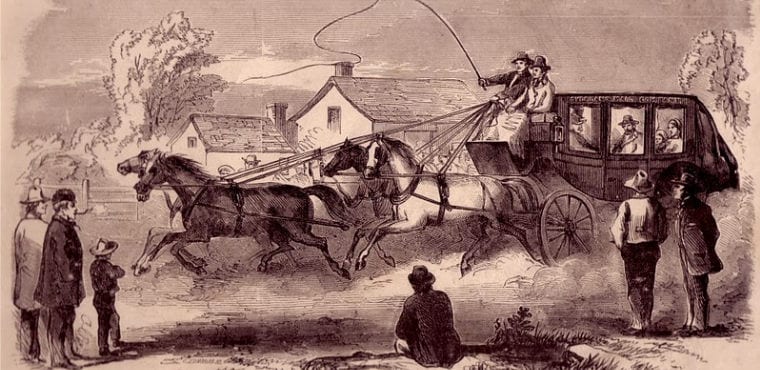By Dr. Curtis Varnell
The Butterfield Stage is one of the most recognizable names from old westerns. Virtually every movie had a scene where wild Indians or wilder outlaws chased after the poor travelers huddled within the coach, often one with an injured driver holding on for dear-life. Few realize that part of that storied history passed right through the small towns and villages of the Arkansas River Valley.
John Butterfield started the line in 1858, primarily to deliver mail to California but carried passengers to increase the profit margin. Two feeder routes carried passengers into Fort Smith, the jumping off site to those traveling to California. One originated in St. Louis, Missouri with stops in Rogers, Fayetteville, and Northwest Arkansas. The second arm of the stage began in Memphis, went through Little Rock and along present day I-40, crossed the Arkansas River near Dardanelle, and followed the old military road into Fort Smith.
The stage line, began in 1858, employed over 1,500 men who maintained local stations, drove the coaches, fed the passengers, and took care of the horses and mules required to pull the stage coaches.
The ticket cost around $200 which would be equivalent to several thousand dollars in today’s money. Travel in the coaches was uncomfortable; often the coach carried as many as nine passengers in an area about the size of a modern car. Passengers rode three to a seat, facing each other with legs dovetailed. On steep grades such as the Boston Mountains, they had to get out and walk.
The stage averaged between five and ten miles per hour with stops to change horses or mules every ten to fifteen miles. In our region, stops were made at Conway, Morrilton, and then the large station at Pottsville. The stage then crossed the river by ferry at Dardanelle and continued up the Military Road. The Stinnett family maintained a large station near Delaware, a station existed at Shoal Creek, then Creole station near Subiaco, Moffet’s station near Short Mountain at Paris, just north of Charleston, and the station in Lavaca. The final leg ended on Third Street in Fort Smith. At Fort Smith, passengers disembarked and waited to join with the passengers coming from St. Louis and then continued the two-thousand mile, twenty-five day trip to California.
Traveling the route today, one can still see remnants of that history. The beautiful and historic Potts Tavern still stands. I passed the old barn on Shoal Creek every morning on my bus route and watched over the years as it slowly disintegrated into dust. Foundation stones can still be seen at Creole station, and historical markers are found at Stinnett’s station and in Lavaca.
Senator Boozeman office has recently expressed an interest in making Butterfield Stage an historic route. Walking through the dust on the old military road as a youth, I would never have dreamed that the old road contained so many secrets and stories of our past.









